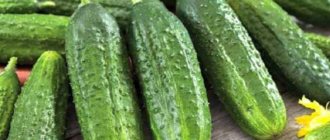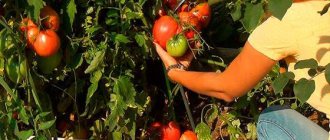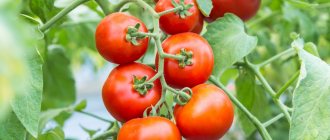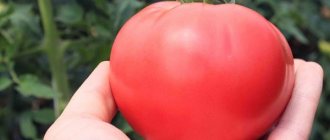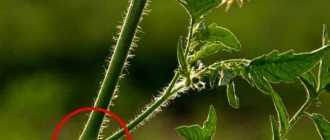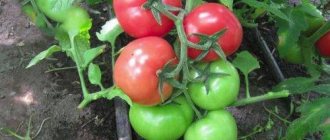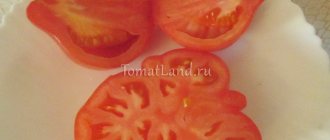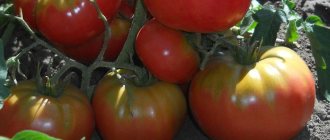The Kangaroo Heart tomato produces large, appetizing fruits, the weight of which can exceed 0.5 kg. This variety is popular among owners of greenhouses and shelters; it grows worse in open ground. The bushes have excellent productivity.
| Height | Landing location | Ripening time | Fruit color | Fruit size | Origin | Fruit shape |
| Tall | Greenhouse | Mid-early | Reds | Large | Variety | Plum-shaped or oval |
Description and characteristics of the variety
The Kangaroo Heart tomato was created in Russia more than two decades ago. It can be grown in all corners of the Russian Federation and in neighboring countries, but it is recommended to do this in greenhouses or, in extreme cases, under film. Gardeners in the southern regions can plant bushes in open ground and get a good harvest if there are no frosts and prolonged rains.
The variety has an indeterminate bush 1.8-2 m high. The leaves are ordinary, the plant is powerful and strong. The ripening period is medium or mid-early - the minimum period that ripening takes is 110 days after the first shoots.
The fruits have a rounded heart-shaped shape, which is why the variety got its name. Their color is red or dark red. Weight ranges from 300 to 600 g depending on care. There are many chambers with seeds inside, the pulp is very tasty, juicy, and fleshy. The variety is suitable for any consumption, except for whole-fruit canning.
To get tomatoes over 500 g, the bush is grown into one stem and some of the set fruits are removed from the clusters, and rich fertilizing is also applied.
Description of yield
If agricultural techniques are followed, the yield of the variety is more than 4 kg. from one bush . The fruits themselves are large in size, beautiful in appearance, weighing from 0.400 to 1 kg.
Description of tomato:
- shape – elongated heart-shaped;
- the skin is bright, dark red;
- pulp – fleshy, dense, sugary, with a small number of seeds;
- taste – dessert, sweetish.
Fruits of universal use, with the best performance in the preparation of natural juice and tomato sauce.
Landing
The bushes are planted in a greenhouse once the threat of frost has disappeared. Sowing of seedlings is carried out 55-60 days before. Before sowing, the seeds are checked for germination and treated:
- First, they are poured into salt water and only those that go to the bottom are selected for planting (those that float up, as a rule, turn out to be empty).
- Then prepare a one percent pink solution of potassium permanganate and immerse the grains in it for half an hour.
- Remove and rinse or soak in clean water for another half hour.
- Prepare a solution of a stimulant according to the instructions - for example, the drug Epin, and treat the seeds with it.
- If desired, you can germinate them by placing them on a piece of damp cloth in a saucer with water poured into the bottom so that the seeds do not float, but come into contact with the liquid. In this case, you can plant it when sprouts of 1-2 mm appear.
Aloe juice has disinfecting and stimulating properties. It is recommended to soak the seeds in it for several hours instead of other procedures.
Then prepare a mixture of soil for seedlings. You can purchase ready-made soil labeled “for tomatoes and peppers.” If it is not there, take 1 part each of garden soil, humus (can be replaced with compost) and lowland peat. Add 0.5 parts of sand or sawdust and measure the acidity. If the pH value exceeds 6.5, add wood ash or a few tablespoons of crushed chalk until the acidity decreases. Then fertilize with superphosphate (2 tsp per 10 kg of mixture).
Sow the seeds in small furrows, moisten them, cover the boxes with transparent oilcloth and allow them to germinate in a warm place. Then they provide the seedlings with +22 degrees during the day and +16-18 at night. Light for at least 16 hours a day, rotate the boxes so that the sun hits the plants evenly.
In the phase of 2 leaves, picking is done. It is convenient to use peat pots, from which you do not need to remove the plants before planting them in the greenhouse.
If there are no peat pots, some gardeners recommend rolling up containers from several layers of newspaper.
In the greenhouse, 3 plants are planted per 1 square meter. m in a checkerboard pattern.
Advantages and disadvantages, reviews of culture
The impressive size of the fruit is not the only reason to plant a tomato in your garden:
- The fleshiness is so great that there is practically no room left for seeds. The dense pulp can even be cut into slices and made into sandwiches.
- The taste of tomato excludes the slightest sign of sourness.
- Care is simple and consists of traditional manipulations (fertilizing, watering and pinching).
- The fruits do not crack.
- Long-term storage is allowed. It is possible to harvest green and wait for the tomatoes to turn red indoors.
- The thick skin does not wrinkle when transporting tomatoes.
- Genetic immunity to a large number of nightshade diseases.
Flaws:
- Formation required.
- Growing mainly in greenhouses.
Reviews:
- In areas with short summers, you need to be prepared for boxes of green tomatoes. To some extent, this is even more convenient; the harvest is not threatened by pests and heavy rains (Valentina, Irkutsk region).
- The variety is rare and not sold in all stores. The packages are small, up to 5 seeds. This amount is enough for a good harvest. The stems are tall, the ovary is abundant, the size of the tomatoes increases with each subsequent cluster (Yaroslav, Krasnodar region).
Features of care
After planting, it is better to immediately install high supports or trellises, taking into account the possible growth of tomatoes. The bushes are tied under the third leaf.
All lateral stepsons up to the first flower-bearing raceme are immediately removed. Subsequent tying and pinching is carried out as it grows.
Tomatoes are watered only with warm water. The best time is early morning or late evening. Watering is carried out strictly at the root, generously once a week or daily in small doses. It is better to install a drip irrigation system.
It is recommended to regularly weed, loosen, mulch the soil, and hill up the bushes.
The variety is responsive to both mineral complexes and organic matter. Organic fertilizers are preferred in the first phase of growth, when nitrogen is needed for bush formation.
With the beginning of flowering, it is preferable to use mineral complexes enriched with potassium and phosphorus. Fertilizing is always combined with watering.
Photo
For a more detailed acquaintance with the Kangaroo Heart variety, you can look at the photographs below.
You can also watch this video, where an experienced gardener will tell you how the Kangaroo Heart variety grew in a greenhouse.
It is not difficult to grow the Kangaroo Heart variety; even a novice gardener can cope with it. The only difficulty may arise when observing temperature and light conditions, but this is all possible. Good luck growing this beautiful tomato variety.
Tomatoes pink heart
This variety appeared relatively recently and is one of the varieties of the Bull's Heart tomato. The tomato is recommended for growing in the southern regions, and in the middle zone - in greenhouse conditions or with shelter.
Description of the variety
Pink heart is mid-early, ripening begins 100-115 days after planting. During the season, the bush produces an average of 2.5 -3 kg of tomatoes, however, with more sparse plantings, the yield increases to 9 kg. The heart-shaped, bright pink fruits fully justify the name of the variety. On average, one tomato weighs 300-350 g, but the first ones can reach 500 g. The pulp is sweet in taste, juicy, soft, the skin is resistant to cracking, but cannot withstand transportation. Pink heart is ideal for salads, as well as for making juice, ketchup, etc.; it does not last long when fresh.
The variety is indeterminate, the bush in open ground reaches an average height of 180 cm. Growth continues almost the entire season, and therefore, despite the massive stems, the tomato requires a garter. At the same time, the shape of the bush is standard and pinching is not necessary. This variety is recommended for cultivation in southern regions with a warm and stable climate. In the middle zone, the tomato needs shelter or greenhouse conditions.
Advantages and disadvantages
Pink heart is a popular variety among summer residents, as it has a number of advantages. Vegetable growers note a large number of ovaries, rapid ripening of fruits, and resistance to many types of pests and pathogens. Well, the most important plus: the juicy pulp tastes sweet.
But, like all crops, tomato has disadvantages. Due to the thin skin, the fruits do not last long and do not tolerate transportation, which is why large farms do not choose it for cultivation. The variety is demanding in terms of growing conditions and care. Compared to other varieties, the yield of Pink Heart is low. In addition, tall bushes require more area for themselves.
Features of cultivation
Since Pink Heart is a heat-loving variety, it is best to grow it using seedlings. Sowing should be done without burying the seeds in the ground. Germination must occur at a temperature of at least 25 degrees. Drying out the soil can be disastrous for sprouts, so you need to establish regular moderate moisture with warm water. After the seeds have sprouted, the air temperature should become lower
It is important to provide good lighting for the seedlings during this period of time. Picking is carried out after the appearance of 2 true leaves
10-15 days before planting in a permanent place, tomatoes must undergo a hardening procedure.
The Pink Heart is planted 55-60 days after seed germination, when the bush has 6-7 leaves and a brush. In addition, the air temperature should warm up to +15 degrees.
When preparing planting areas, it is worth considering that the bushes grow large, and the distance between them should be at least 30 cm, and the number of seats should be more than 3 per 1 square meter. m planning is not advisable. During the replanting process, the root collar should not be buried in order to protect it from root rotting.
You can water once every 3 days in the absence of precipitation. Excess moisture slows down the development of the root system and provokes fungal diseases.
To help the plant adapt to new conditions, as well as accumulate nutrients for abundant fruiting, it is necessary to apply organic and mineral fertilizers. Universal mineral mixtures are applied once every 15 days.
A necessary measure for the Pink Heart tomato is a garter. Under the weight of the fruits, the bushes bend towards the soil surface, where they can become prey for pests and microorganisms.
To increase the yield of this variety, experienced vegetable growers resort to forming a bush according to a pattern of 1 or 2 stems. Such measures make it possible to increase fruiting by 30%. When growing a tomato with 1 stem, the intervals between bushes can be reduced. When using the 2-stem scheme, the first shoot is left above the first cluster; after 2 inflorescences appear on it, the crown is pinched and all other stepsons are torn off. But on such bushes the fruits are formed in smaller sizes than on bushes formed into 1 stem.
Tomatoes Heart of a kangaroo on video
If you grew Kangaroo Heart tomatoes, please write what you liked about this variety, and why it perhaps disappointed you. Will you plant it again? Briefly describe the advantages and disadvantages of this tomato in your opinion, and evaluate its taste. Would you recommend this variety to others?
Your reviews of the Kangaroo Heart tomato and additions to the description will help many gardeners evaluate this variety more objectively and decide whether it is worth planting or not.
Fans of sweet and very large tomatoes will be interested in the “Kangaroo Heart” variety. Vegetable growers owe the appearance of this unpretentious and high-yielding variety to Russian breeders. For more than 20 years, Kangaroo Heart has been pleasing gardeners with its unpretentiousness and rich fruiting.
Sowing seeds
The timing of sowing seeds depends on the planned date of planting the seedlings in a permanent place. This date depends on the growing region and is determined by the time when the likelihood of return frosts is minimized. It is optimal to sow 60 days before transplantation. The soil for seedlings must be fertile, loose and neutral in acidity.
The soil mixture prepared independently or purchased must be cleaned of pathogenic bacteria by any disinfection method. Before planting, seeds are soaked for 30 minutes in a light solution of manganese, and then in any ready-made solution to increase immunity. The next day, the seeds are sown to a depth of 2 cm, the soil on top is slightly compacted.
Water the seedlings exclusively with warm water, and when two true leaves appear, plant them in separate pots. Two weeks before planting in a permanent place, they are hardened according to the usual scheme at low temperatures.
You should know! It is important to check seeds for germination before planting. This is easy to determine - you need to put the seeds in salted water and wait 5 minutes
Seeds unsuitable for planting will float.
Tomato “Crushed heart”
PACKING: Zip-lock bag 12 – 15 SEEDS
Such beautiful fruits! Yes, this is a gift to a loved one.
1. Original title:
Crushed heart. Also in many sources it was translated as Broken Heart, Crushed Heart, Wounded Heart, Heart in Love. Or simply – Crashed damn. Obviously the name is related to love.
2. History:
this variety is a new product from the famous breeder Brad Gates (USA).
3. Plant characteristics:
ripening period is mid-season. Long-term fruiting. Grows well in open ground, but is more productive in a greenhouse. The bush is indeterminate, tall, 150-180 cm. The stem is thin, liana-like. The leaf is simple, drooping. The flower cluster is simple, 4-6 fruits are tied.
4. How to shape:
The Crushed heart variety is best grown in 2 stems. It is necessary to tie up and tie up.
5. Shape and weight of the fruit:
The shape of the fruits is exceptional – heart-shaped. Near the petiole there are wide, very rarely there may be shallow ribs. At the top of the fruit there is a thin, sharp or blunt nose. Real heart! Fruit weight is 150-200 grams.
6. Tomato color:
The variety has a bright, painted color. On a crimson background, green, then yellow, orange strokes and stripes appear. But near the petiole, under the influence of the sun, there is quite a bit of anthocyanin in the form of a gray-blue color. When cut, the flesh is pink.
7. Taste:
The tomatoes are moderate in sweetness, the taste is delicate and light. The aroma is bright, tomato with spicy notes. The structure of the pulp is oily, fleshy, the walls are thick. Juice in moderation.
8.Usage:
universal. Both under the lid and in the salad. For pasta and juice. They are stored for a short time after harvesting and soften. But there were no cracks in the skin.
The variety is young and in rare cases there may be slight modifications: with sudden temperature changes, there is a lack of anthocyanin. But the variety is very beautiful. Fruits until frost!
For many, it grows without anthocyanin. But we collect the seeds of the right fruits. If you want to continue stabilizing the variety, then also collect seeds for yourself from fruits that have black smears - anthocyanin.


